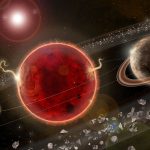Images of Mars from a NASA rover confirm the Jezero crater was once a lake fed by a small river about 3.7 billion years ago, say experts.
The first scientific analysis of the pictures indicates where the Perseverance rover could look for signs of life and shows how much water flowed into the crater.
It also reveals evidence that Jezero suffered flash floods.
The findings are based on images of rocks from the crater’s western side.
Satellite pictures had shown the outcrop resembled Earth’s river deltas, where sediment layers are left in the shape of a fan as a river feeds into slower-moving or stagnant water.
The images taken by Perseverance from inside the crater confirm the Jezero outcrop was a river delta.
The lake was calm for much of its life, according to the study, until a dramatic change in climate caused episodes of flooding.
Mars was doomed to become a barren lifeless planet from the beginning, says new study
Women in science: Aiming for the stars – but for how long?
The sound of Mars: Chinese release recording of Martian surface by their rover lander
Scientists say the flooding swept large boulders tens of miles – from highlands well outside the crater – and left them on the lake bed, where they remain today.
“If you look at these images, you’re basically staring at this epic desert landscape. It’s the most forlorn place you could ever visit,” said Professor Benjamin Weiss from Massachusetts Institute of Technology (MIT).
“There’s not a drop of water anywhere, and yet, here we have evidence of a very different past.
“Something very profound happened in the planet’s history.”
Please use Chrome browser for a more accessible video player
Scientists believe the sediment could reveal fossilised traces of life and Perseverance will now look for places to collect samples that will eventually be returned to Earth.
The NASA rover landed in the Jezero crater on 18 February – along with the Ingenuity Mars helicopter – and has been collecting samples and sending back images.
It’s due to spend at least two years exploring the area.
“It will take some time to get to the rocks that we really hope to sample for signs of life. So, it’s a marathon, with a lot of potential,” said Tanja Bosak, associate professor of geobiology at MIT.
Professor Weiss added: “The most surprising thing that’s come out of these images is the potential opportunity to catch the time when this crater transitioned from an Earth-like habitable environment, to this desolate landscape wasteland we see now.
“These boulder beds may be records of this transition, and we haven’t seen this in other places on Mars.”
The study’s findings are published in the journal Science.






















